Australian Indigenous Economic Development Strategy and Capabilities
VerifiedAdded on 2020/02/24
|8
|1669
|50
Essay
AI Summary
This economics essay delves into the Australian Indigenous Economic Development Strategy, analyzing its alignment with Amartya Sen's capabilities approach. The essay begins by defining the capabilities approach, emphasizing its focus on human well-being, functioning, and freedom. It then examines how the Australian strategy, particularly the Indigenous Economic Development Strategy 2011-18, attempts to incorporate these principles through initiatives promoting education, employment, and economic empowerment for Indigenous Australians. The essay critically assesses the strategy's successes and limitations, highlighting areas where it aligns with and deviates from the capabilities approach. It discusses instances where policies have conflicted with the approach, such as past protectionist practices and a focus on human capital over capabilities. The essay concludes by emphasizing the need for a comprehensive implementation of the capabilities approach to ensure genuine economic development and well-being for Indigenous communities, while also acknowledging the influence of the human capital approach within the current strategy. The essay references various sources to support its arguments.
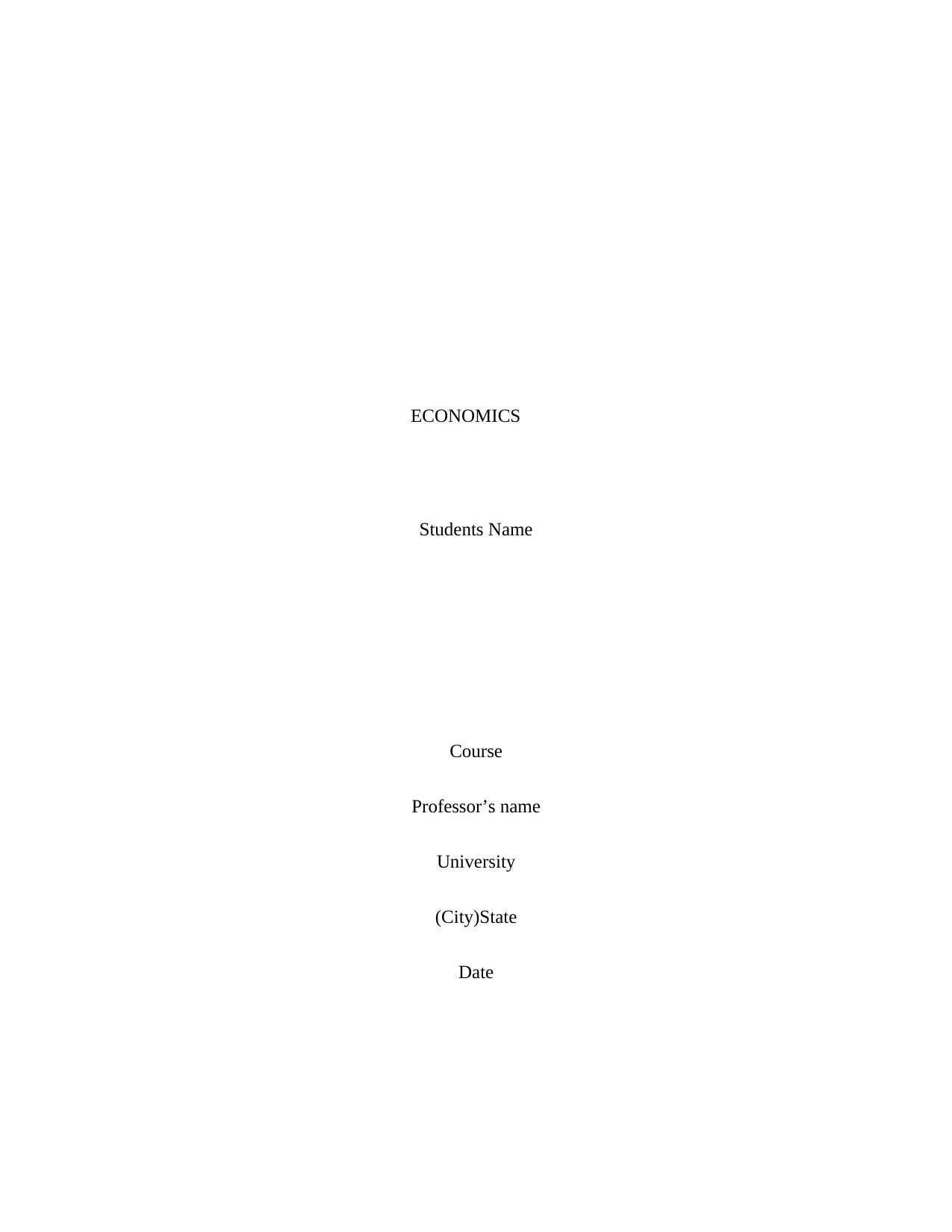
ECONOMICS
Students Name
Course
Professor’s name
University
(City)State
Date
Students Name
Course
Professor’s name
University
(City)State
Date
Paraphrase This Document
Need a fresh take? Get an instant paraphrase of this document with our AI Paraphraser
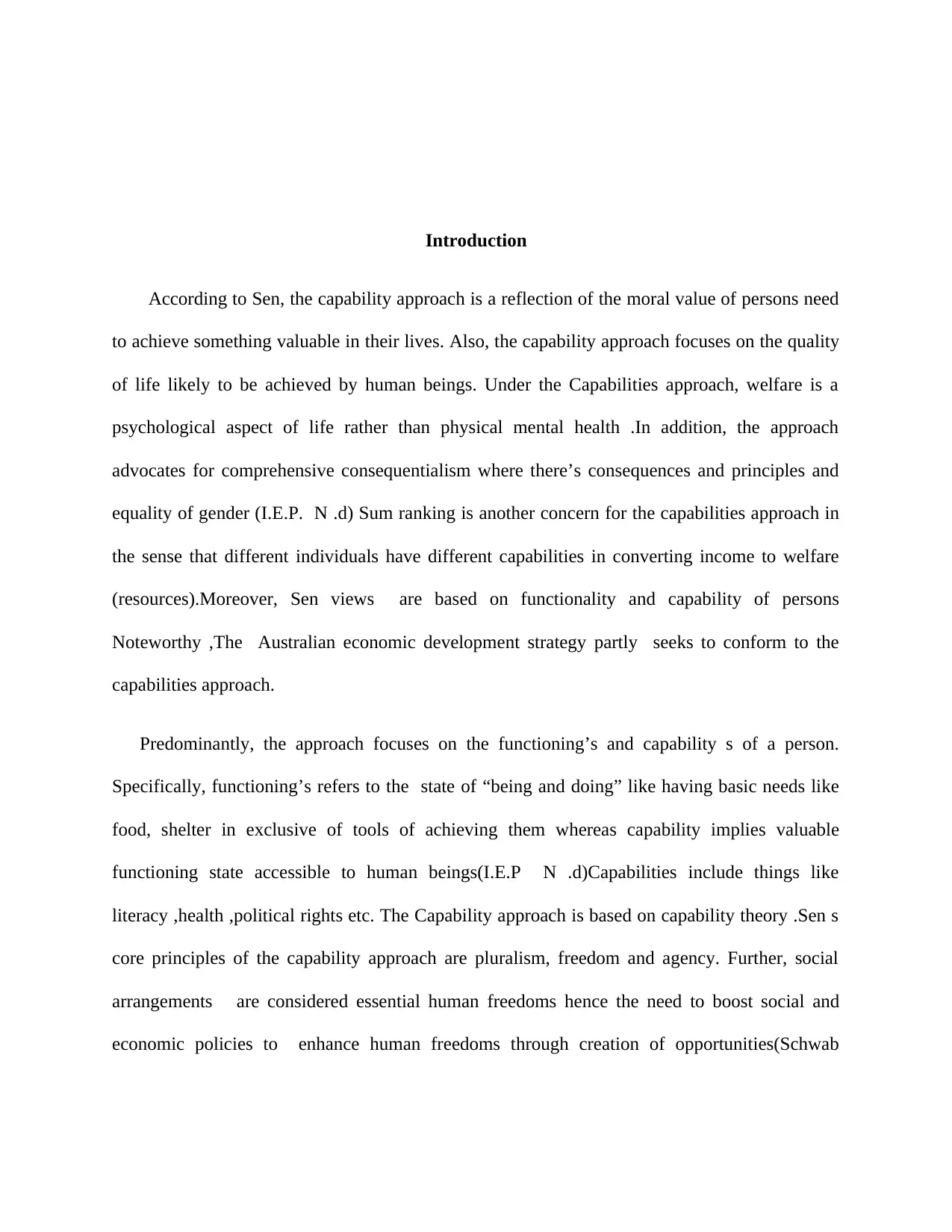
Introduction
According to Sen, the capability approach is a reflection of the moral value of persons need
to achieve something valuable in their lives. Also, the capability approach focuses on the quality
of life likely to be achieved by human beings. Under the Capabilities approach, welfare is a
psychological aspect of life rather than physical mental health .In addition, the approach
advocates for comprehensive consequentialism where there’s consequences and principles and
equality of gender (I.E.P. N .d) Sum ranking is another concern for the capabilities approach in
the sense that different individuals have different capabilities in converting income to welfare
(resources).Moreover, Sen views are based on functionality and capability of persons
Noteworthy ,The Australian economic development strategy partly seeks to conform to the
capabilities approach.
Predominantly, the approach focuses on the functioning’s and capability s of a person.
Specifically, functioning’s refers to the state of “being and doing” like having basic needs like
food, shelter in exclusive of tools of achieving them whereas capability implies valuable
functioning state accessible to human beings(I.E.P N .d)Capabilities include things like
literacy ,health ,political rights etc. The Capability approach is based on capability theory .Sen s
core principles of the capability approach are pluralism, freedom and agency. Further, social
arrangements are considered essential human freedoms hence the need to boost social and
economic policies to enhance human freedoms through creation of opportunities(Schwab
According to Sen, the capability approach is a reflection of the moral value of persons need
to achieve something valuable in their lives. Also, the capability approach focuses on the quality
of life likely to be achieved by human beings. Under the Capabilities approach, welfare is a
psychological aspect of life rather than physical mental health .In addition, the approach
advocates for comprehensive consequentialism where there’s consequences and principles and
equality of gender (I.E.P. N .d) Sum ranking is another concern for the capabilities approach in
the sense that different individuals have different capabilities in converting income to welfare
(resources).Moreover, Sen views are based on functionality and capability of persons
Noteworthy ,The Australian economic development strategy partly seeks to conform to the
capabilities approach.
Predominantly, the approach focuses on the functioning’s and capability s of a person.
Specifically, functioning’s refers to the state of “being and doing” like having basic needs like
food, shelter in exclusive of tools of achieving them whereas capability implies valuable
functioning state accessible to human beings(I.E.P N .d)Capabilities include things like
literacy ,health ,political rights etc. The Capability approach is based on capability theory .Sen s
core principles of the capability approach are pluralism, freedom and agency. Further, social
arrangements are considered essential human freedoms hence the need to boost social and
economic policies to enhance human freedoms through creation of opportunities(Schwab
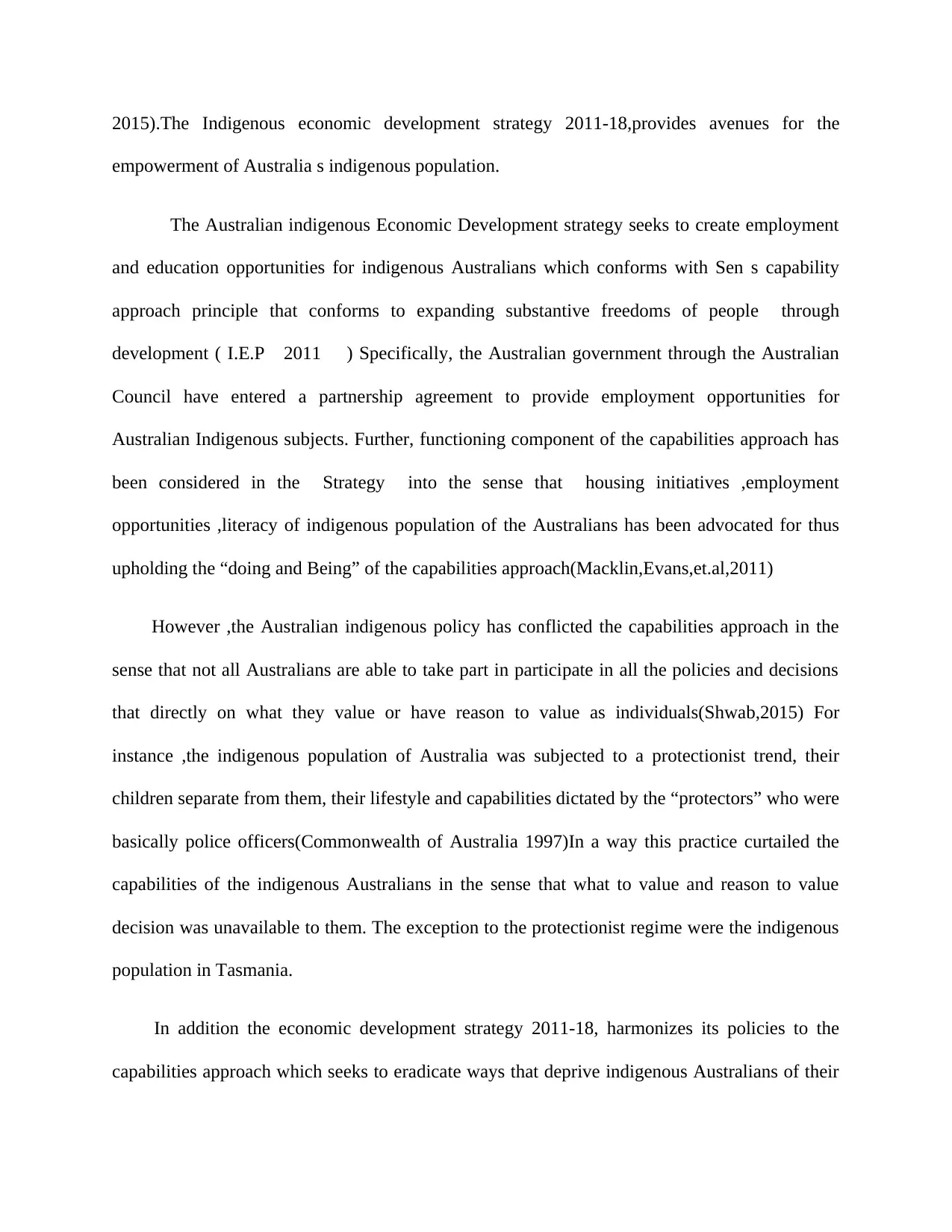
2015).The Indigenous economic development strategy 2011-18,provides avenues for the
empowerment of Australia s indigenous population.
The Australian indigenous Economic Development strategy seeks to create employment
and education opportunities for indigenous Australians which conforms with Sen s capability
approach principle that conforms to expanding substantive freedoms of people through
development ( I.E.P 2011 ) Specifically, the Australian government through the Australian
Council have entered a partnership agreement to provide employment opportunities for
Australian Indigenous subjects. Further, functioning component of the capabilities approach has
been considered in the Strategy into the sense that housing initiatives ,employment
opportunities ,literacy of indigenous population of the Australians has been advocated for thus
upholding the “doing and Being” of the capabilities approach(Macklin,Evans,et.al,2011)
However ,the Australian indigenous policy has conflicted the capabilities approach in the
sense that not all Australians are able to take part in participate in all the policies and decisions
that directly on what they value or have reason to value as individuals(Shwab,2015) For
instance ,the indigenous population of Australia was subjected to a protectionist trend, their
children separate from them, their lifestyle and capabilities dictated by the “protectors” who were
basically police officers(Commonwealth of Australia 1997)In a way this practice curtailed the
capabilities of the indigenous Australians in the sense that what to value and reason to value
decision was unavailable to them. The exception to the protectionist regime were the indigenous
population in Tasmania.
In addition the economic development strategy 2011-18, harmonizes its policies to the
capabilities approach which seeks to eradicate ways that deprive indigenous Australians of their
empowerment of Australia s indigenous population.
The Australian indigenous Economic Development strategy seeks to create employment
and education opportunities for indigenous Australians which conforms with Sen s capability
approach principle that conforms to expanding substantive freedoms of people through
development ( I.E.P 2011 ) Specifically, the Australian government through the Australian
Council have entered a partnership agreement to provide employment opportunities for
Australian Indigenous subjects. Further, functioning component of the capabilities approach has
been considered in the Strategy into the sense that housing initiatives ,employment
opportunities ,literacy of indigenous population of the Australians has been advocated for thus
upholding the “doing and Being” of the capabilities approach(Macklin,Evans,et.al,2011)
However ,the Australian indigenous policy has conflicted the capabilities approach in the
sense that not all Australians are able to take part in participate in all the policies and decisions
that directly on what they value or have reason to value as individuals(Shwab,2015) For
instance ,the indigenous population of Australia was subjected to a protectionist trend, their
children separate from them, their lifestyle and capabilities dictated by the “protectors” who were
basically police officers(Commonwealth of Australia 1997)In a way this practice curtailed the
capabilities of the indigenous Australians in the sense that what to value and reason to value
decision was unavailable to them. The exception to the protectionist regime were the indigenous
population in Tasmania.
In addition the economic development strategy 2011-18, harmonizes its policies to the
capabilities approach which seeks to eradicate ways that deprive indigenous Australians of their
⊘ This is a preview!⊘
Do you want full access?
Subscribe today to unlock all pages.

Trusted by 1+ million students worldwide
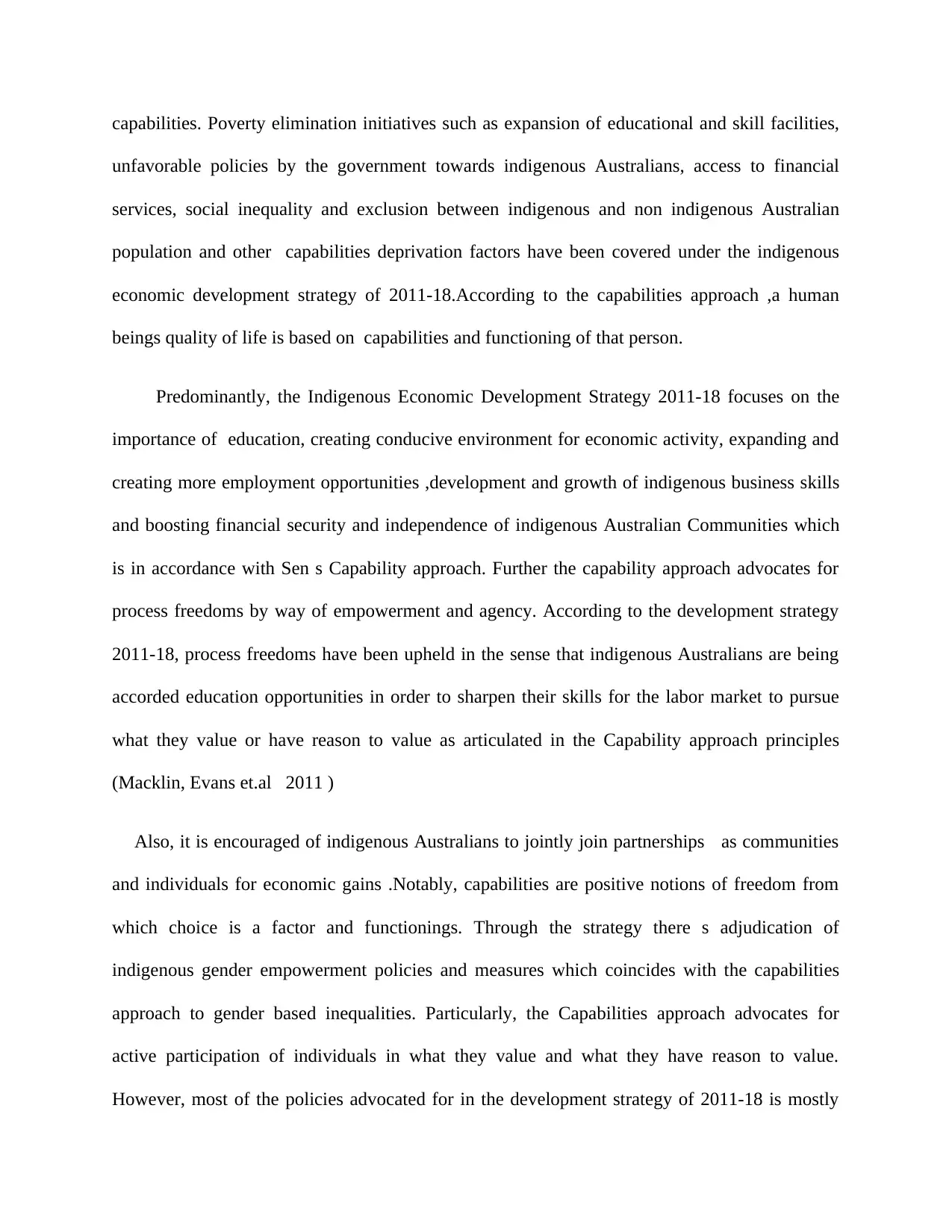
capabilities. Poverty elimination initiatives such as expansion of educational and skill facilities,
unfavorable policies by the government towards indigenous Australians, access to financial
services, social inequality and exclusion between indigenous and non indigenous Australian
population and other capabilities deprivation factors have been covered under the indigenous
economic development strategy of 2011-18.According to the capabilities approach ,a human
beings quality of life is based on capabilities and functioning of that person.
Predominantly, the Indigenous Economic Development Strategy 2011-18 focuses on the
importance of education, creating conducive environment for economic activity, expanding and
creating more employment opportunities ,development and growth of indigenous business skills
and boosting financial security and independence of indigenous Australian Communities which
is in accordance with Sen s Capability approach. Further the capability approach advocates for
process freedoms by way of empowerment and agency. According to the development strategy
2011-18, process freedoms have been upheld in the sense that indigenous Australians are being
accorded education opportunities in order to sharpen their skills for the labor market to pursue
what they value or have reason to value as articulated in the Capability approach principles
(Macklin, Evans et.al 2011 )
Also, it is encouraged of indigenous Australians to jointly join partnerships as communities
and individuals for economic gains .Notably, capabilities are positive notions of freedom from
which choice is a factor and functionings. Through the strategy there s adjudication of
indigenous gender empowerment policies and measures which coincides with the capabilities
approach to gender based inequalities. Particularly, the Capabilities approach advocates for
active participation of individuals in what they value and what they have reason to value.
However, most of the policies advocated for in the development strategy of 2011-18 is mostly
unfavorable policies by the government towards indigenous Australians, access to financial
services, social inequality and exclusion between indigenous and non indigenous Australian
population and other capabilities deprivation factors have been covered under the indigenous
economic development strategy of 2011-18.According to the capabilities approach ,a human
beings quality of life is based on capabilities and functioning of that person.
Predominantly, the Indigenous Economic Development Strategy 2011-18 focuses on the
importance of education, creating conducive environment for economic activity, expanding and
creating more employment opportunities ,development and growth of indigenous business skills
and boosting financial security and independence of indigenous Australian Communities which
is in accordance with Sen s Capability approach. Further the capability approach advocates for
process freedoms by way of empowerment and agency. According to the development strategy
2011-18, process freedoms have been upheld in the sense that indigenous Australians are being
accorded education opportunities in order to sharpen their skills for the labor market to pursue
what they value or have reason to value as articulated in the Capability approach principles
(Macklin, Evans et.al 2011 )
Also, it is encouraged of indigenous Australians to jointly join partnerships as communities
and individuals for economic gains .Notably, capabilities are positive notions of freedom from
which choice is a factor and functionings. Through the strategy there s adjudication of
indigenous gender empowerment policies and measures which coincides with the capabilities
approach to gender based inequalities. Particularly, the Capabilities approach advocates for
active participation of individuals in what they value and what they have reason to value.
However, most of the policies advocated for in the development strategy of 2011-18 is mostly
Paraphrase This Document
Need a fresh take? Get an instant paraphrase of this document with our AI Paraphraser
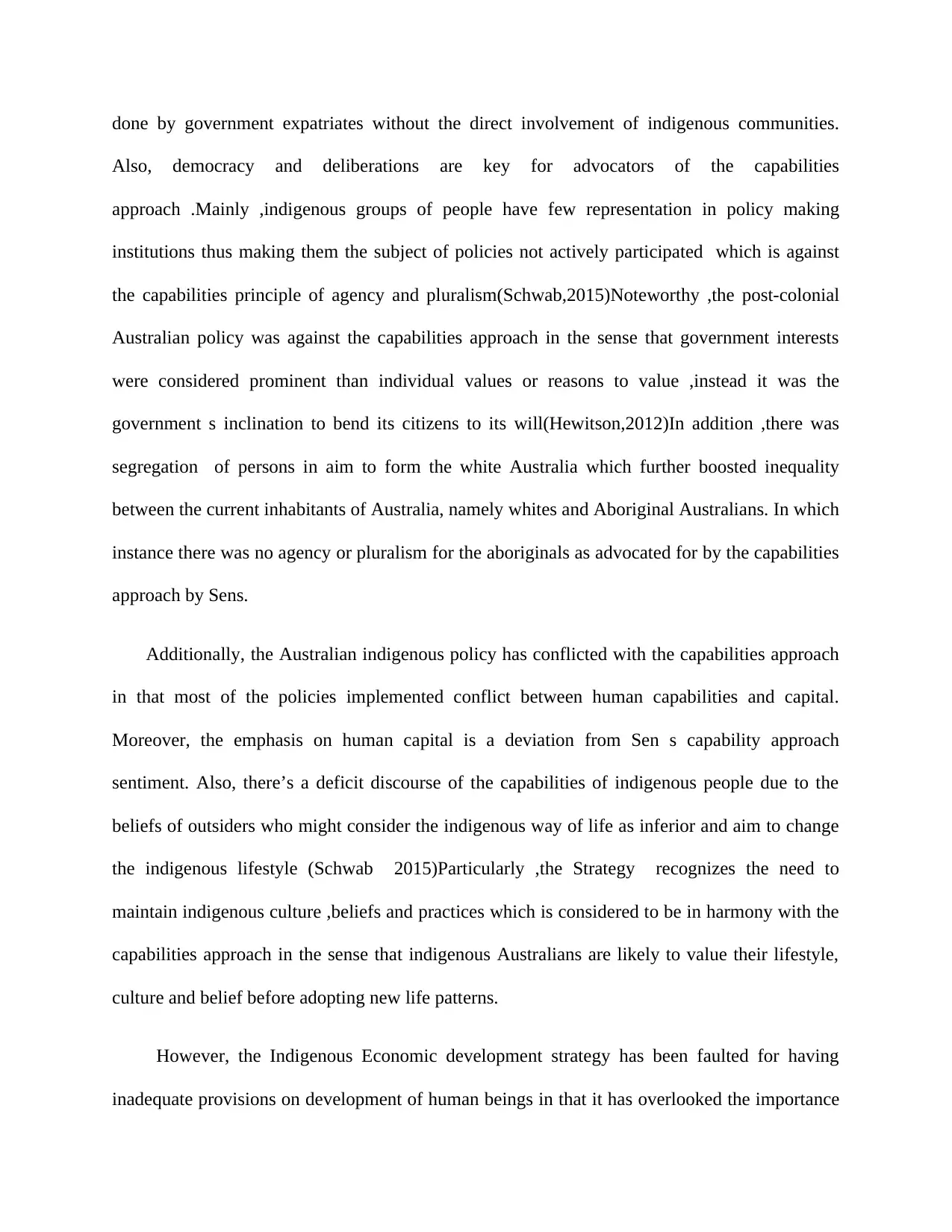
done by government expatriates without the direct involvement of indigenous communities.
Also, democracy and deliberations are key for advocators of the capabilities
approach .Mainly ,indigenous groups of people have few representation in policy making
institutions thus making them the subject of policies not actively participated which is against
the capabilities principle of agency and pluralism(Schwab,2015)Noteworthy ,the post-colonial
Australian policy was against the capabilities approach in the sense that government interests
were considered prominent than individual values or reasons to value ,instead it was the
government s inclination to bend its citizens to its will(Hewitson,2012)In addition ,there was
segregation of persons in aim to form the white Australia which further boosted inequality
between the current inhabitants of Australia, namely whites and Aboriginal Australians. In which
instance there was no agency or pluralism for the aboriginals as advocated for by the capabilities
approach by Sens.
Additionally, the Australian indigenous policy has conflicted with the capabilities approach
in that most of the policies implemented conflict between human capabilities and capital.
Moreover, the emphasis on human capital is a deviation from Sen s capability approach
sentiment. Also, there’s a deficit discourse of the capabilities of indigenous people due to the
beliefs of outsiders who might consider the indigenous way of life as inferior and aim to change
the indigenous lifestyle (Schwab 2015)Particularly ,the Strategy recognizes the need to
maintain indigenous culture ,beliefs and practices which is considered to be in harmony with the
capabilities approach in the sense that indigenous Australians are likely to value their lifestyle,
culture and belief before adopting new life patterns.
However, the Indigenous Economic development strategy has been faulted for having
inadequate provisions on development of human beings in that it has overlooked the importance
Also, democracy and deliberations are key for advocators of the capabilities
approach .Mainly ,indigenous groups of people have few representation in policy making
institutions thus making them the subject of policies not actively participated which is against
the capabilities principle of agency and pluralism(Schwab,2015)Noteworthy ,the post-colonial
Australian policy was against the capabilities approach in the sense that government interests
were considered prominent than individual values or reasons to value ,instead it was the
government s inclination to bend its citizens to its will(Hewitson,2012)In addition ,there was
segregation of persons in aim to form the white Australia which further boosted inequality
between the current inhabitants of Australia, namely whites and Aboriginal Australians. In which
instance there was no agency or pluralism for the aboriginals as advocated for by the capabilities
approach by Sens.
Additionally, the Australian indigenous policy has conflicted with the capabilities approach
in that most of the policies implemented conflict between human capabilities and capital.
Moreover, the emphasis on human capital is a deviation from Sen s capability approach
sentiment. Also, there’s a deficit discourse of the capabilities of indigenous people due to the
beliefs of outsiders who might consider the indigenous way of life as inferior and aim to change
the indigenous lifestyle (Schwab 2015)Particularly ,the Strategy recognizes the need to
maintain indigenous culture ,beliefs and practices which is considered to be in harmony with the
capabilities approach in the sense that indigenous Australians are likely to value their lifestyle,
culture and belief before adopting new life patterns.
However, the Indigenous Economic development strategy has been faulted for having
inadequate provisions on development of human beings in that it has overlooked the importance
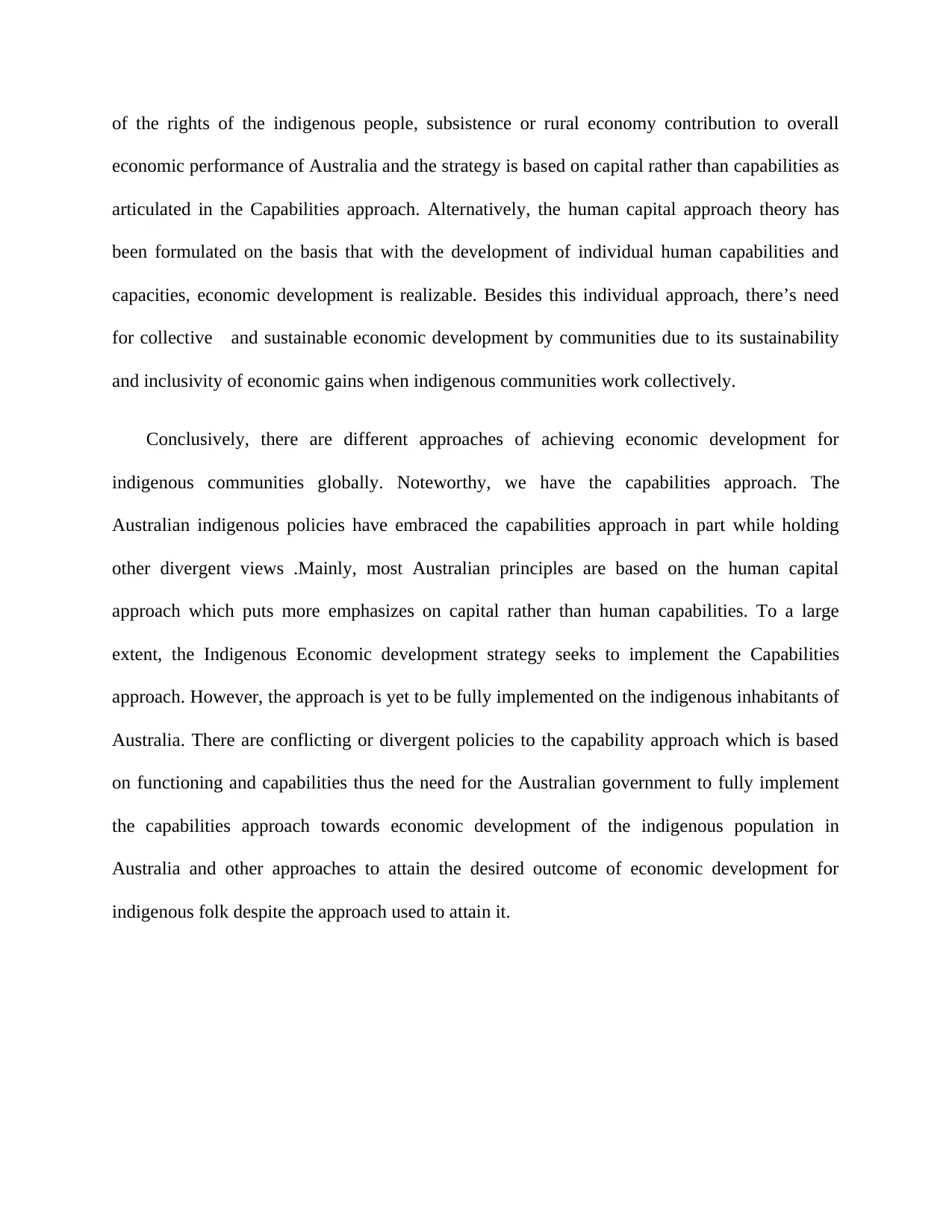
of the rights of the indigenous people, subsistence or rural economy contribution to overall
economic performance of Australia and the strategy is based on capital rather than capabilities as
articulated in the Capabilities approach. Alternatively, the human capital approach theory has
been formulated on the basis that with the development of individual human capabilities and
capacities, economic development is realizable. Besides this individual approach, there’s need
for collective and sustainable economic development by communities due to its sustainability
and inclusivity of economic gains when indigenous communities work collectively.
Conclusively, there are different approaches of achieving economic development for
indigenous communities globally. Noteworthy, we have the capabilities approach. The
Australian indigenous policies have embraced the capabilities approach in part while holding
other divergent views .Mainly, most Australian principles are based on the human capital
approach which puts more emphasizes on capital rather than human capabilities. To a large
extent, the Indigenous Economic development strategy seeks to implement the Capabilities
approach. However, the approach is yet to be fully implemented on the indigenous inhabitants of
Australia. There are conflicting or divergent policies to the capability approach which is based
on functioning and capabilities thus the need for the Australian government to fully implement
the capabilities approach towards economic development of the indigenous population in
Australia and other approaches to attain the desired outcome of economic development for
indigenous folk despite the approach used to attain it.
economic performance of Australia and the strategy is based on capital rather than capabilities as
articulated in the Capabilities approach. Alternatively, the human capital approach theory has
been formulated on the basis that with the development of individual human capabilities and
capacities, economic development is realizable. Besides this individual approach, there’s need
for collective and sustainable economic development by communities due to its sustainability
and inclusivity of economic gains when indigenous communities work collectively.
Conclusively, there are different approaches of achieving economic development for
indigenous communities globally. Noteworthy, we have the capabilities approach. The
Australian indigenous policies have embraced the capabilities approach in part while holding
other divergent views .Mainly, most Australian principles are based on the human capital
approach which puts more emphasizes on capital rather than human capabilities. To a large
extent, the Indigenous Economic development strategy seeks to implement the Capabilities
approach. However, the approach is yet to be fully implemented on the indigenous inhabitants of
Australia. There are conflicting or divergent policies to the capability approach which is based
on functioning and capabilities thus the need for the Australian government to fully implement
the capabilities approach towards economic development of the indigenous population in
Australia and other approaches to attain the desired outcome of economic development for
indigenous folk despite the approach used to attain it.
⊘ This is a preview!⊘
Do you want full access?
Subscribe today to unlock all pages.

Trusted by 1+ million students worldwide
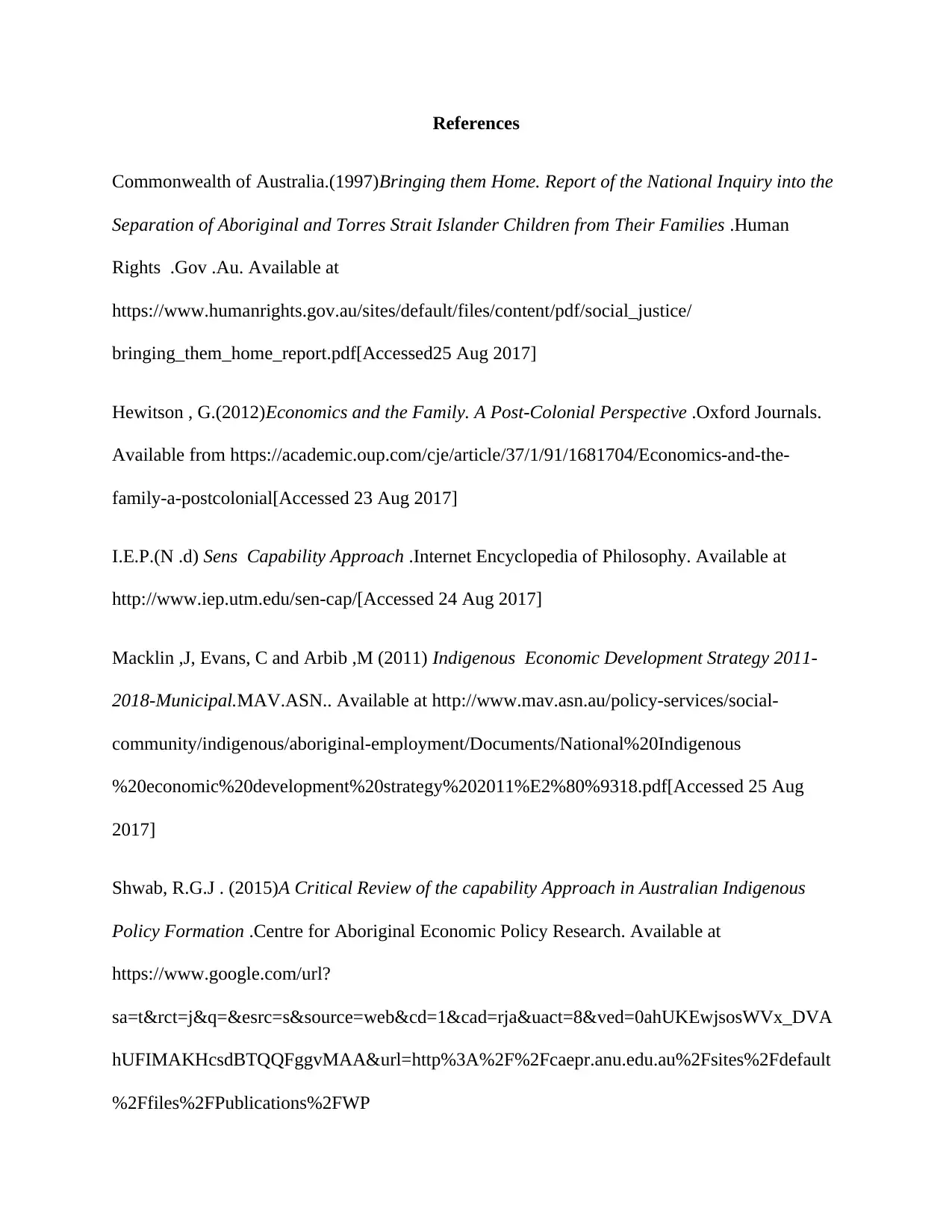
References
Commonwealth of Australia.(1997)Bringing them Home. Report of the National Inquiry into the
Separation of Aboriginal and Torres Strait Islander Children from Their Families .Human
Rights .Gov .Au. Available at
https://www.humanrights.gov.au/sites/default/files/content/pdf/social_justice/
bringing_them_home_report.pdf[Accessed25 Aug 2017]
Hewitson , G.(2012)Economics and the Family. A Post-Colonial Perspective .Oxford Journals.
Available from https://academic.oup.com/cje/article/37/1/91/1681704/Economics-and-the-
family-a-postcolonial[Accessed 23 Aug 2017]
I.E.P.(N .d) Sens Capability Approach .Internet Encyclopedia of Philosophy. Available at
http://www.iep.utm.edu/sen-cap/[Accessed 24 Aug 2017]
Macklin ,J, Evans, C and Arbib ,M (2011) Indigenous Economic Development Strategy 2011-
2018-Municipal.MAV.ASN.. Available at http://www.mav.asn.au/policy-services/social-
community/indigenous/aboriginal-employment/Documents/National%20Indigenous
%20economic%20development%20strategy%202011%E2%80%9318.pdf[Accessed 25 Aug
2017]
Shwab, R.G.J . (2015)A Critical Review of the capability Approach in Australian Indigenous
Policy Formation .Centre for Aboriginal Economic Policy Research. Available at
https://www.google.com/url?
sa=t&rct=j&q=&esrc=s&source=web&cd=1&cad=rja&uact=8&ved=0ahUKEwjsosWVx_DVA
hUFIMAKHcsdBTQQFggvMAA&url=http%3A%2F%2Fcaepr.anu.edu.au%2Fsites%2Fdefault
%2Ffiles%2FPublications%2FWP
Commonwealth of Australia.(1997)Bringing them Home. Report of the National Inquiry into the
Separation of Aboriginal and Torres Strait Islander Children from Their Families .Human
Rights .Gov .Au. Available at
https://www.humanrights.gov.au/sites/default/files/content/pdf/social_justice/
bringing_them_home_report.pdf[Accessed25 Aug 2017]
Hewitson , G.(2012)Economics and the Family. A Post-Colonial Perspective .Oxford Journals.
Available from https://academic.oup.com/cje/article/37/1/91/1681704/Economics-and-the-
family-a-postcolonial[Accessed 23 Aug 2017]
I.E.P.(N .d) Sens Capability Approach .Internet Encyclopedia of Philosophy. Available at
http://www.iep.utm.edu/sen-cap/[Accessed 24 Aug 2017]
Macklin ,J, Evans, C and Arbib ,M (2011) Indigenous Economic Development Strategy 2011-
2018-Municipal.MAV.ASN.. Available at http://www.mav.asn.au/policy-services/social-
community/indigenous/aboriginal-employment/Documents/National%20Indigenous
%20economic%20development%20strategy%202011%E2%80%9318.pdf[Accessed 25 Aug
2017]
Shwab, R.G.J . (2015)A Critical Review of the capability Approach in Australian Indigenous
Policy Formation .Centre for Aboriginal Economic Policy Research. Available at
https://www.google.com/url?
sa=t&rct=j&q=&esrc=s&source=web&cd=1&cad=rja&uact=8&ved=0ahUKEwjsosWVx_DVA
hUFIMAKHcsdBTQQFggvMAA&url=http%3A%2F%2Fcaepr.anu.edu.au%2Fsites%2Fdefault
%2Ffiles%2FPublications%2FWP
Paraphrase This Document
Need a fresh take? Get an instant paraphrase of this document with our AI Paraphraser

%2FWorkingPaper102_2015_Klein.pdf&usg=AFQjCNHMB13JW_NFgoFh2PrL
posHrwOh3A[Accessed 25 Aug 2017]
posHrwOh3A[Accessed 25 Aug 2017]
1 out of 8
Related Documents
Your All-in-One AI-Powered Toolkit for Academic Success.
+13062052269
info@desklib.com
Available 24*7 on WhatsApp / Email
![[object Object]](/_next/static/media/star-bottom.7253800d.svg)
Unlock your academic potential
Copyright © 2020–2025 A2Z Services. All Rights Reserved. Developed and managed by ZUCOL.



